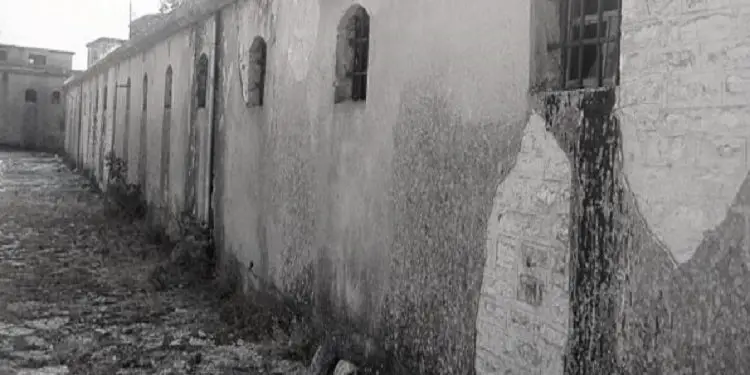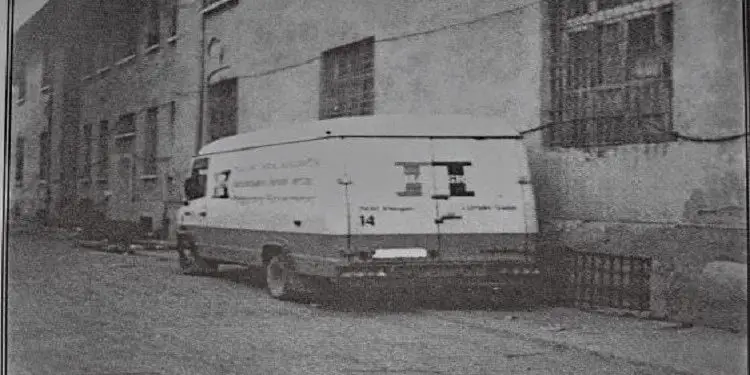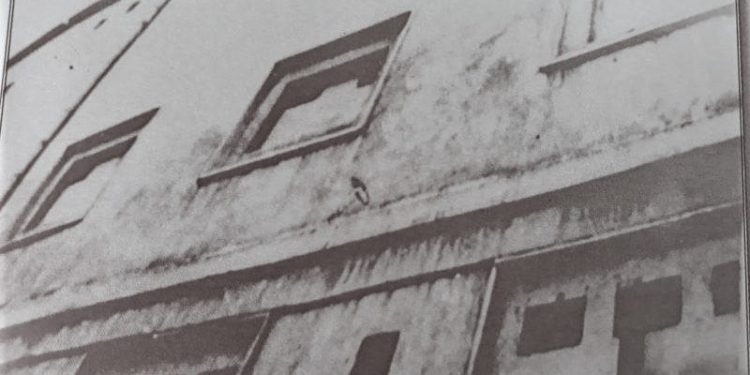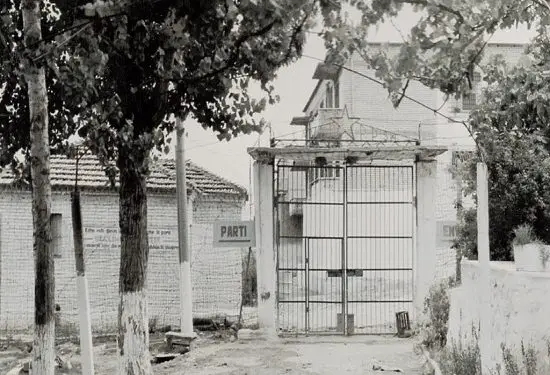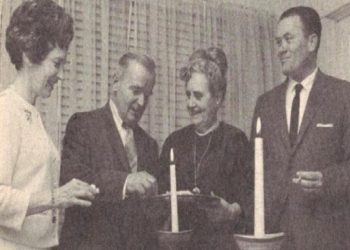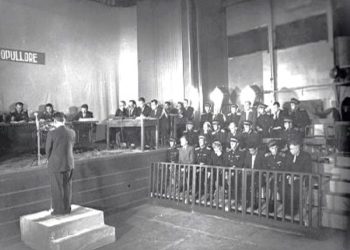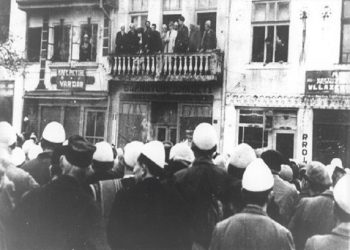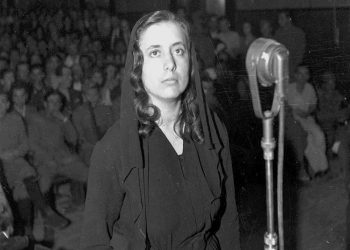From Agim Musta
The first part
Memorie.al / On the fourth anniversary of the death of the well-known historian, researcher, writer and publicist Agim Musta, (July 24, 2019), former political prisoner, his daughters Elizabeta and Suela, gave him the right and exclusivity for the publication, by the online media Memorie.al, of one of the author’s most prominent publications, such as the ‘Black Book of Albanian Communism’. This work contains numerous data, evidence, facts, statistics and arguments unknown to the general public, on communist crimes and terror in Albania, especially against intellectuals, in the period 1945-1991. The publication for the first time of parts of this book, on the well-known platform Memorie.al, is the realization of one of the bequests of the historian Agim Musta, who, from the beginning of 1991 until his death, for nearly three decades engaged with all his powers, working to raise the collective memory, through book publications and publications in the daily press. All that voluminous work of Mr. Agim Musta, concretized in several books, is a contribution of great value to the disclosure of the crimes of the communist regime of Enver Hoxha and his successor, Ramiz Alia. A good part of the publications of Mr. Agim Musta, is also translated into English. Thanking the two daughters of the late Musta, who chose Memorie.al, to commemorate their father, from today, we are starting the publication, piece by piece, of the “Black Book of Albanian Communism”.
-The prisons of the Albanian communist state-
(1945-1991)
- Closed prisons
During the monarchical regime (1928-1939) there were 5 prisons in Albania: Gjirokastër, Korçë, Durrës, Tirana and Shkodër. At the beginning of the thirties, in the castle of Gjirokastra, the largest prison of the Monarchy was built, which was called the “General Prison of the Albanian Kingdom”, with a capacity of 400 places. The Italian invaders built in Tirana in 1940, a high security military prison, which was called by the people; “The New Prison”. This prison, together with the cells, had a capacity of up to 300 people.
- Closed prisons
It should be noted that during the Italian occupation, in the police and carabinieri commands, in the ten prefectures of Albania, a large number of cells were built, which were used for detainees for political reasons. The Italian fascist invaders built three internment camps in Albania: in Porto-Palermo, Porto-Romano and in the Four Roads of Shijak. In these camps, anti-fascist elements and Albanian soldiers, who had deserted from the Italian fascist military units, were imprisoned.
The number of internees in these camps reached about 2000 people. From the invaders, 795 Albanians were interned on the islands of Italy: Sardinia, Ventotene, Ustika and in other Italian prisons. During the period of the Italian occupation, from April 7, 1939 to September 8, 1943, 87 people were executed for political reasons.
During the German occupation, September 1943 – November 1944, in Albania, the existing prisons functioned in the main cities of the country, cells near the Feldgjindarmeria commands, in Vlorë, Korçë, Tirana and Shkodër.
The number of prisoners in this period fell to 1000 people, after the German Gestapo penetrated the Pristina camp, 350 former prisoners, 102 of whom were shot in October 1944. From the Nazi invaders, during that period, more than 1,600 people, most of them citizens from Vlora and Durrës, were infiltrated to the Nazi camps in Germany. Most of these unfortunates were burned in the crematoriums of Auschwitz, Majdanik and Dakaut.
With the establishment of the communist dictatorship in Albania, only during the period of 1945-1948, about 10,000 people were arrested for political reasons. They were participants in the political organizations of the ‘National Front’, ‘Legality’, collaborators of the Quisling governments, members and supporters of the fighting forces of the Northern Bajraktars, clergy, taxed merchants, rich, who were forcibly asked to hand over gold and of inherited jewels, former partisan deserters, various people, who showed opinions against the power in power, etc.
Among them there were people from all strata of Albanian society. As the existing prisons and cells were filled to overflowing, many more prisons were erected in all the important urban centers. In Shkodër, during the period 1945-1949, 12 churches and schools were turned into prisons; in Peshkopi and Kukës, the military barracks were turned into prisons; in Gjirokastër the flour factory was turned into a prison, while in some cities, such as Vlora, Elbasan, Berat and Korçë, many private apartments were turned into prisons.
- Gjirokastra prison
The Gjirokastra prison was built in the early thirties, in the middle of the castle. The castle itself was used as a prison and place of execution, since the time of the Zenebish, Venetians, Ottomans, until the beginning of the 20th century. Together with the prison built in the middle of it, it has an amazing view, which is rarely seen in other Balkan countries.
The prison and castle resemble a magnificent cruiser in the middle of the ocean. In the center of the prison, there is a large hall with 7 windows or 7 windows that looked over the city market. In Gjirokastra, “7 windows” became synonymous with prison. In addition to the large hall with a capacity of 120 seats, the prison also had two branches, with small rooms for 4-6 people.
At the same time, the prison had an annex with 3-4 rooms for women. On the eastern side, there were 20 cells called the Babica sector. During the years 1945-1946, the cells were adapted to the underground floors, in eternal darkness. This prison, which had a capacity of 400 people, in the first years of the communist dictatorship, managed to hold over 1,200 people. Until 1949, only 400 gr was given to prisoners as food. cornbread During this 3-year period, more than 120 people, among them prominent intellectuals, such as Colonel Selaudin Mborja, etc., have died from the poor food and bad treatment in the prison.
Even from the Gjirokastra prison, although it is of high security, there have been escape attempts, some of which ended successfully. This prison was closed in 1954 and some of its premises were turned into the National Weapons Museum, some others were adapted for refrigerators.
- Tepelena prison
After the invasion of Czechoslovakia by Soviet troops and the Warsaw Pact in 1968, the dictator Enver Hoxha, thinking that such an intervention could also happen in Albania, ordered the construction of a high-security prison, where former cadres would be isolated the top of the Party – state, called enemies of the party and the people and condemned by the dictatorship. The place where the prison was to be built was chosen to be the gorge of Bênça, a very isolated place, 5 km. away from the city of Tepelena.
The prison was surrounded by a 6 meter high stone wall and barbed wire was placed on top of it. On the upper floor were the command offices and the guards’ dormitories, while in the 7 rooms on the first floor, the isolated prisoners were placed in three groups. In January 1971, the first prisoners were brought to this prison.
Among them were former high-ranking members of the Party-state such as: Bedri Spahiu, former member of the Political Bureau, Koço Tashko, former ambassador plenipotentiary of Albania in Moscow and chairman of the Party Revision Commission, Maqo Çomo, former minister of Agriculture, Gjin Marku, former general and others. The prisoners protested many times about the hermetic isolation and the extraordinary regulation used in this prison.
At the end of 1972, without waiting or remembering, Tepelena prison was closed. It was said that the reason for its closure was that it was built in an unsuitable place and unprotected from any diversionary attack.
- Vlora prison
The prison of Vlora, before the Italian occupation, was located in a private building adapted for a prison. It had a capacity of 150-200 people. The convicts, who served their sentence there, were ordinaries. Those arrested for political motives in Vlora, as in the case of the anti-monarchist group of 1932, were sent to the Durrës prison. During the fascist occupation, in the cells of the Vlora prison, there were about 100 prisoners, for political reasons. With the establishment of the communist government, about 500 people were imprisoned in this prison for political reasons. To cope with the situation, another prison was built in 1954.
The new prison, with a capacity of 400 people, functioned until 1962. More than 80 prisoners died from torture and executions in Vlora prisons, among them well-known intellectuals: Bego Gjonzeneli, Qazim Kokoshi, Abdulla Mema, and others. . After 1962, the political prisoners of Vlora were partially sent to Burrel prison and forced labor camps.
- Berat prison
The prison of the city of Berat was built during the Ottoman rule. After the establishment of the communist dictatorship, when the class war deepened and the arrested were added to the town of Berat, they returned to prisons, the “Tomorri” hotel and a private house, near the Gorica Bridge. During the years 1945-1948, in the prisons of Berat, there were about 1,500 prisoners for political reasons.
About 156 people died in these prisons from torture and executions. Among them, there were prominent intellectuals and patriots, such as: Abaz Omari, Ali Kuçi, Kamber Ruli and many others. The prisons of Berat were closed in 1952, when the convicts who were in them were sent for the construction of the airport in Ura Vajgurore and to other camps, with forced labor.
- Korça prison
At the time of the Ottoman occupation, the prisoners of the Korca district were sent to the prison of Manastir (today’s Bitoli) to serve their sentences. The prison of Korça was built in 1916, during the French occupation. Prisoners with heavy sentences, the French took them to the prison of Thessaloniki and to French Guiana.
The prison was modified during the Bird Monarchy period and had a capacity for 150-200 people. During the years 1945-1947, in this prison, the number of convicts for political motives increased, and their number reached about 800 people.
Due to the severe hygienic-sanitary conditions, many fell ill in this prison and some of them lost their lives. To cope with the extremely difficult situation, in 1946, the Metropolis of Korça and some private buildings were converted into prisons. In these buildings, over 100 cells were adapted. With the creation of camps-prisons with forced labor, the prison of Korça, in 1961, was finally closed.
Only the investigation cells remained in operation. Many prominent patriots and intellectuals have died in this prison, such as; Faslli Frashëri, Nafiz Babani, Xhevat Starova, Malik Dushari, etc. It is worth noting that from the prison of Korça in 1949, some prisoners sentenced to death “escaped” together with the guards and policemen. Some of them were caught and executed, while the others, led by Ali Starova , were able to escape abroad.
- Elbasan prison
The Elbasni prison was located in a private house adapted for a prison, within the walls of the “Kala” neighborhood of this city. The prison had a capacity of up to 150 people. The building was very small and all damp. The rays of the sun never entered this edifice of suffering. With the establishment of the communist dictatorship, in Elbasan prison, the number of prisoners for political motives reached about 300 people.
The hygienic living conditions in the premises of this prison were much worse than in other prisons of the Republic. Many prisoners died and were secretly buried at night, on the coast of Zaranik. Among them was the student of the Pedagogical School of Elbasan, 16-year-old Behaudin Basha. In 1950, the political prisoners of this prison were transferred to other prisons. Elbasan prison was finally closed in 1951.
- Durrës prison
At the beginning of the 20s, a private house, in the “Jevgjve Neighborhood”, was adapted for a prison in the city of Durrës. Its capacity was for about 120 people. During the time of the Monarchy, in this prison they conducted the investigation and the conspirators of the Vlora group of 1932 and the participants of the Fier uprising of 1935 have partially served their sentence.
After the establishment of the communist dictatorship, Durrës prison was populated with about 300 prisoners, for political reasons. Many respected patriots, intellectuals and clerics died in this prison, such as: Mustafa Varoshi, Vincens Prenushi and others. The prison of Durrës was closed in the early 1950s and the convicts in it were sent to forced labor camps.
- The Old Prison of Tirana
The Old Prison of Tirana was built in 1932. It is a two-story building and has two courtyards on the two sides. Before the Italian occupation, it was a prison for ordinary convicts and in rare cases; there were also convicts for political reasons. Initially, Tirana Prison had a capacity for 200 people. In the western part of the prison, there was an annex building, which was used for convicted women.
During the fascist occupation, in the old prison of Tirana, there were more than 200 prisoners and convicts for political reasons. In the yard of this prison, in 1941, the assassin of the Emperor of Italy, the brave man from Piqeras of Saranda, Vasil Laçi, as well as other anti-fascist fighters, was executed by hanging.
With the establishment of the communist dictatorship, more than 1000 prisoners, convicted of political crimes, were gathered in the Old Prison of Tirana. To cope with the unusually difficult situation, in 1946, behind the prison building, 50 cells were built, so-called; “Dungeons of Kochi”.
Among the convicts of this prison, several hundred people, prominent intellectuals and patriots, were shot and died from torture, such as: Aqif Përmeti, Kol Tromara, Bahri Omari, Father Anton Harapi, Lef Nosi, Shasivar Islami, Baba Kamberi, Abdyl Sharra . Sazani, Irfan Majuni, Agathokli Xhitomi, Riza Dani, Syrja Selfo, Faik Shehu, Hilmi Hysi, Jani Koljaka, Kostaq Stefa, Mahmut Maçi, and many others, many of whom, neither their remains nor their graves were found.
In later years, when the forced labor camps were opened, the Old Prison of Tirana was turned into a transit prison, where convicts who were past the age and suffering from incurable diseases were kept. The dungeons of this prison, both the early ones and those built in 1946, remained in operation until July 4, 1991, when the last prisoners convicted for political motives were released.
- The New Prison of Tirana
The New Prison of Tirana was built by the Italian occupiers in 1940. Half of it consisted of cells and investigation rooms. In the other part, there were rooms for prisoners who had been sentenced. In front of the prison, there was a yard surrounded by very high concrete walls. During the period of 1940-1941, only military prisoners were kept in this prison.
For this reason, in those years this prison was also called the Military Prison of Tirana. During the years 1942 and 1943, there were also many prisoners for political reasons. In 1943, a group of communists led by Koçi Xoxen, sentenced in this prison, were able to get out of it through a tunnel. For this action of theirs, they had the help of the internal guards of the prison.
After the establishment of the communist dictatorship in Albania, this prison was overpopulated and part of its premises was used as a hospital-prison. Many officers of the Albanian Kingdom were taken from this prison for execution.
It is worth noting that a group of officers led by Major Murat Basha, when they were taken for shooting, began to sing the Anthem of the Flag, without batting an eyelash. Another act of bravery in this prison was done by the young man from Libohova, Muharrem Bejleri. After breaking out of the dungeon where he was locked up, he was able to grab a gun in the police room and tried to escape, but he was dictated to and started shooting at him, by all the prison’s bodyguards.
Muharrem, was positioned in the prison yard, responding to fire with fire. Alarm occupied the Ministry of Internal Affairs and the General Prosecutor’s Office. With dozens of senior cadres, they ran in alarm towards the prison.
Their order was clear, for the annihilation of the fugitive. After an hour of unequal struggle, Muharrem was killed by bombs thrown from the roof of the prison. His bravery remained in the oral annals of prisons for many years. In this prison, the high cadres of the Party – State: Beqir Balluku, Kadri Hazbiu, Feçor Shehu, Petrit Dume, Hito Çako, Abdyl Këllezi, Koço Theodhosi, Kiço Ngjela, and others, conducted the special investigation.
- Burrell’s prison hell
The Burrel prison was started to be built at the beginning of 1938 by the Albanian Kingdom, but remained unfinished, due to the Italian invasion on April 7, 1939. The Italians turned the Burrel prison into horse stables. After the establishment of the communist dictatorship, its rehabilitation was completed and in 1946, the first prisoners were sent there from all the prisons of Albania.
In this prison, intellectuals graduated from the Universities of Europe, anti-communist clerics and nationalist patriots sentenced to severe punishments were sent. The Burrel prison has the shape of a parallelepiped with a height of 4 meters above the ground, with a width of 6 meters and a length of 100 meters. There are 10 rooms and in the middle of the prison, there are 30 dungeons, which are separated by a corridor.
The prison and its yard are surrounded by a 4-meter high concrete wall and a dense barbed wire is placed above it. From the outside, only the surrounding wall is visible and nothing else. For this reason, word spread among the people that the prison of Burrell was underground. The capacity of the prison was for 400 people, but 600 prisoners were brought there.
During the period of 1946-1949, the prisoners were fed only 400 grams of corn bread per day; they were not allowed to meet their families and were not given any medical assistance. The motto that was repeated every day by the officers and guards of the prison was: “Here they say Burrel, (he goes in and doesn’t come out).
Between the years 1946-1949, about 300 prisoners died in this prison, who was buried in a common pit, behind the prison, near a cherry tree. In this period, the director of the prison was Lieutenant Vangjel Rrêmbeci, a loyal man of the Minister of Internal Affairs, Koçi Xoxes, who had authorized this sadist to exterminate the elite of the Albanian intelligence. By his order, former Prime Minister Koço Kota, Officer Atif Golja and teacher Spiro Grameno were locked in a cell until they died.
In 1953, a group of senior Soviet K.G.B. officers visited Burrell prison. They were amazed by the miserable condition in which the convicts were. An ex-convict, Muharrem Xhakoni, who knew the Russian language, took courage and addressed the Russian officers with these words: “Gentlemen! Under these dirty rags, diplomas from the best universities in Europe are hidden”! Memorie.al
The next issue follows





